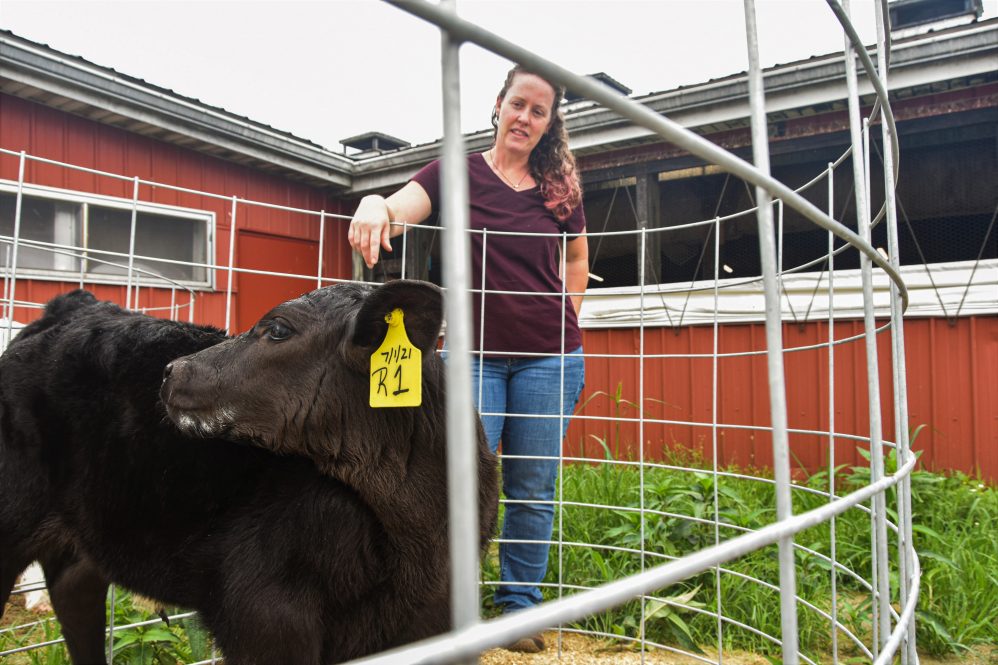Cattle farmers have historically raised cattle specifically suited for either dairy or beef production. But farmers are now looking to get the best of both worlds with crossbred calves who will produce better beef than purebred dairy calves.
Associate professor of animal science in the College of Agriculture, Health, and Natural Resources, Sarah Reed is investigating proper feeding strategies for beef x dairy crossbred calves, as they are different than those suitable for purebred dairy or purebred beef calves. The team for this project includes Reed’s UConn colleagues Steven Zinn, Joe Emenheiser, and Kristen Govoni, and Tara Felix from Penn State University.
There is an increasing trend of using beef semen in dairy cows to produce crossbred calves. In 2019, Hoard’s Dairyman magazine reported a 59% increase in dairy producers’ use of beef semen. Seventy-nine percent of respondents to a preliminary survey Reed distributed to farmers in the northeastern United States use beef semen and 38.5% indicated they may consider it in the future.
Dairy cattle are bred to put more energy into eventual lactation, whereas beef cattle put more energy toward muscle growth and fat. This means that dairy calves raised for beef are not genetically well-suited for beef production and farmers get a lesser return on these calves.
Crossbreeding provides an economic advantage to dairy farmers as it produces calves that are better suited for beef. These crossbred calves provide farmers with a greater return while maintaining their dairy herds and milk production levels.
Thanks to a wealth of knowledge about dairy cow genetics, farmers can identify which cows in their herd will produce the best offspring for producing milk. The rest can be crossbred with beef semen to produce calves that will grow more like beef cattle.
In the preliminary survey, requests for information about nutritional guidance was the most commonly requested, highlighting the importance of Reed’s study.
The main reasons farmers are not using beef semen is a lack of financial return and a lack of knowledge about crossbreeding. Reed’s project will address both barriers by developing guidance that informs farmers about how to make their crossbred calves more profitable.
“Through this project, we will determine best practices for nutritional management of these calves and, simultaneously, develop cost-benefit analyses to determine if the economic return is worth the investment,” Reed says. “Together, this information will be used to educate producers on these best practices and allow them to improve their current programs or initiate new beef-dairy breeding strategies in their herd.”
In her research examining feeding strategies, Reed will focus on the critical period during calves’ first eight months of life. Reed hypothesizes that better post-natal nutrition will produce higher-quality beef calves which will in turn provide farmers with a better economic return. Delivering proper nutrition at this early stage of life will likely support better growth later in life.
Beef calves traditionally stay with their mothers for the first few months of their lives and nurse from them. However, dairy cows’ milk needs to be used for dairy products, meaning the calves need to be fed with a milk replacer.
Reed and her team will provide calves with one of two commercially available milk replacers, with different fat and protein contents, for the first 56 days of life. Then the calves will be weaned onto either calf grower or a corn-based feed. Once they reach 500 pounds, all calves will be transitioned onto a high-grain diet.
By using commercially available milk replacements and other feedstuffs, this study will provide farmers with an easily applicable, affordable strategy to produce the best stock possible.
Reed’s team will use calf body weights and measurements as well as measures of muscle and fat content to determine the effect of each experimental treatment. Felix and Emenheiser will develop educational materials to disseminate their findings to farmers. This guidance can help make the crossbred calves more suitable for the beef market by producing higher-quality calves.
This work has the potential to increase the profitability of northeast dairies by diversifying their products. Reed’s approach is suitable for dairy farms of any size or at any location.
Reed holds a Ph.D. in animal molecular and cell biology from the University of Florida. Her research interests include how poor maternal diet during gestation alters offspring muscle development and pre- and post-natal muscle growth and the characterization of muscle satellite cells in horses.
This project is funded through a grant from the Northeast SARE.
Follow UConn CAHNR on social media.



